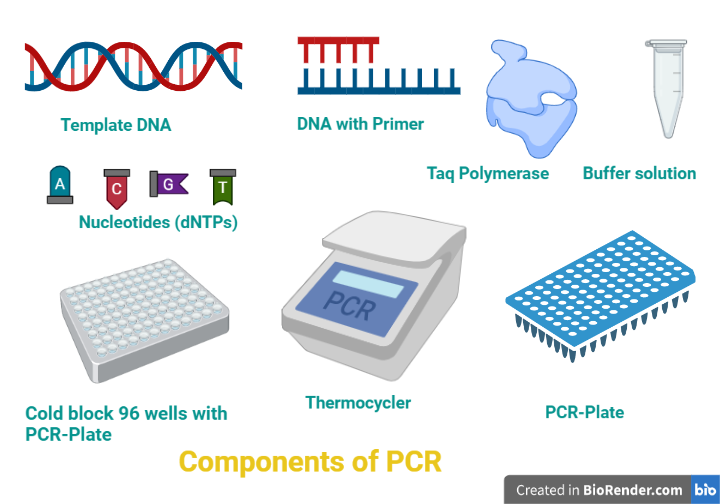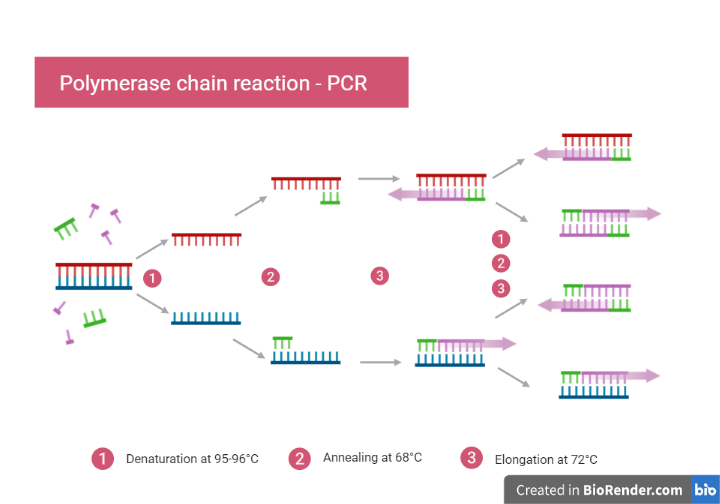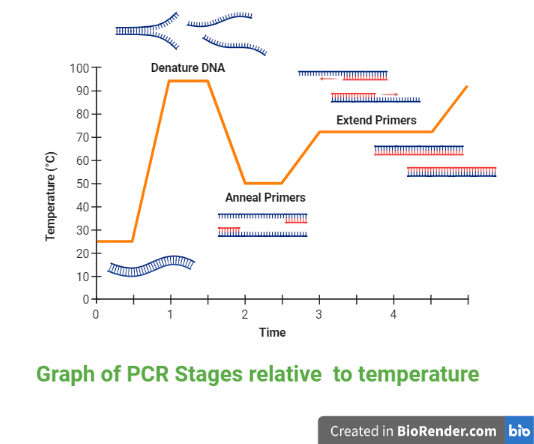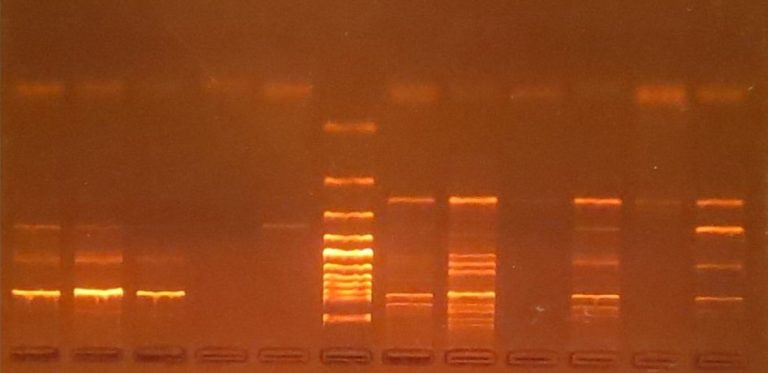Introduction:
Polymerase chain reaction (PCR) is an in vitro replication of specific DNA sequences that can generate billions of copies of a particular DNA fragment (the sequence of interest, DNA of interest, or target DNA) from a DNA extract (DNA template).
PCR is a powerful tool used to exponentially amplify a specific target DNA sequence for downstream experimental procedures. It is employed in a variety of molecular biology techniques, including cloning, gene expression profiling, site-directed mutagenesis, genotyping, and sequencing.
History:
In 1985, the use PCR technique in the prenatal diagnosis of sickle-cell anaemia was firstly published. Kary Mullis developed PCR in 1983 and was awarded Nobel Prize in chemistry. Since its introduction, the polymerase chain reaction has undergone numerous advancements and is now widely utilized for a variety of purposes, including genotyping, cloning, mutation detection, sequencing, microarrays, forensics, and paternity testing.
Principle:
Multiple copies of a DNA fragment from an extract can be obtained in an invitro method through PCR. Denaturation, primer-mediated hybridization, and elongation are the three steps that make up the process.
Components:
1. DNA template
It comprises the portion of the DNA fragment that will be amplified by PCR. The quality and quantity of the template DNA are essential for effective amplification of the region of interest.
2. Primers
A primer is a short segment of nucleotides that is complementary to the DNA region of our interest that will be amplified during PCR. To initiate the elongation phases of the PCR, primers are annealed to the denatured DNA template.
3. Taq polymerase
The term “Taq polymerase” refers to the heat-stable DNA polymerase isolated from the thermophilic bacterium Thermus aquaticus.
It is a crucial tool for amplifying particular DNA sequences that is used to systematize the repeating processes in the PCR. In a test tube, the polymerase chain reaction may replicate DNA molecules up to a billion times, producing enormous quantities of particular genes for use in various applications.
4. Deoxyribonucleoside triphosphates (dNTPs)
The dNTPS (dATP, dGTP, dCTP, dUTP) provide both energy and nucleotides for the synthesis of DNA. It is very important to add equal amount of PCR mix to prevent mismatches of the bases.
5. PCR buffer
It contains Tris, MgCl2 and KCl with pH 8.3 that maintain the pH of the master mixture.
In addition, magnesium act as a co-factor for the enzymes Taq polymerase that enhance the primer annealing, specificity, and decreased the formation of primer dimmers during reaction.
6. Dimethyl sufoxide (DMSO)
DMSO is also added to the master mixture if multiple sets of primer are used.
7. PCR additives
BSA (usually at 0.1 to 0.8 µg/µL final concentration), glycerol (usually at 5-10% v/v) are generally used as additives that increases apparent concentration of primer/template mix, and often increases PCR efficiency at high temperatures.
Non-ionic detergents such as Triton X, Tween 20 or Nonidet P-40) and SDS are also employed that help in stabilising the structure of Taq polymerase.
8. Thermal Cyclers
Thermal cyclers are available in multiple sizes and sample holding capacities which is very essential laboratory equipment for researchers that aim in sequencing, cloning, genotyping, mutagenesis, and many other applications.
Common features of thermal cyclers include Peltier effect technology that precisely maintain and regulate temperatures following pre-programmed settings to facilitate temperature-sensitive reactions, and thermal gradient to easily optimize PCR assays in a single run.

Fig: Components of PCR
Sample Preparation:
Preparing samples for PCR typically requires extraction and purification of nuclear material (DNA or RNA). The DNA may include genomic DNA, c-DNA, or mitochondrial DNA as per the aim and objectives of the procedure. There are several types of DNA extraction, isolation, and purification kits, reagents, buffers, available that depend upon the source of the sample, aim and objectives for downstream experimental procedures.
PCR Amplification/Stages of PCR:
The polymerase chain reaction is carried out in a reaction mixture which comprises the starting material (DNA/RNA), Taq polymerase, primers, and the four deoxyribonucleoside triphosphates (dNTPs) in excess in a buffer solution. The tubes containing the mixture reaction are subjected to repetitive temperature cycles in the heating block of a thermal cycler. A thermal cycler is used to perform the following steps, repeating the process 30 to 45 times. The process of the PCR is subdivided into three stages as follows:
Denaturation
It is the unwinding of the two strands of DNA that is facilitated by raising the temperature (94°C). The hydrogen bonds between the complementary nitrogenous bases cannot be maintained at a temperature higher than 80°C. Thus, the double-stranded DNA is denatured into single-stranded DNA (single-stranded DNA).
Annealing/Hybridization
The second step is hybridization. It is the second step that is carried out at a temperature generally between 40 and 70°C in the hybridisation of the primer occur. The complementary strands can hybridize as a result of the hydrogen bonds being able to rebuild as the temperature drops.

Fig: Steps of PCR
Extension/Elongation
In these final stages, temperature is raised to 72-80°C which facilitated the addition of nucleotides to 3′ end the primer that result in the extension of DNA. The polymerase adds the nucleotides by attaching to the primer and eventually adding it to the single strand that result in a double-stranded DNA molecule. A number of DNA sequences of interest can be obtained in a relatively short period of time by repeating these three stages 30–45 times.

Fig: Graph of PCR stages relatives to temperature
PCR product detection and analysis:
Depending on the information desired, there are many different methods to analyse the products of a PCR reaction.
Agarose gel electrophoresis is a common technique to detect the presence or absence of the target sequence and the length of the fragment and to analyse it accordingly. The DNA is revealed by ethidium bromide staining. Thus, the products are instantly visible by ultra-violet (UV) transilluminator.

Fig: Agarose gel electrophoresis to visualize the results of PCR
Types of PCR:
- Conventional PCR
- Real-Time PCR (Quantitative polymerase chain reaction, qPCR)
- Reverse-Transcriptase Real-Time PCR (RT-qPCR)
- End point PCR
- Touch down PCR
- Multiplex PCR
- Colony PCR
- Digital PCR (dPCR)
- Hot start PCR
- Long-Range PCR
- Nested PCR
- Allele-specific PCR
- Amplified fragment length polymorphism (AFLP) PCR
Factors influencing quality of PCR in the laboratory
- Sample integrity:The circumstances of sample collection and shipment have an impact on PCR analysis outcomes.
- Template quality: The template DNA must be of high quality and free of contaminants or inhibitors that can interfere with the amplification process.
- Primer design: The primers used in PCR should be designed to specifically amplify the desired target region and avoid non-specific amplifications.
- Amplicon length: The length of the amplicon (the amplified DNA fragment) can influence the efficiency of the PCR reaction.
- Reaction conditions: The temperature, pH, and salt concentration of the reaction mixture can all affect the efficiency of the PCR reaction.
- Mg2+ concentration: The concentration of Mg2+ in the reaction mixture can affect the efficiency of the PCR reaction.
- Polymerase: The type and quality of the polymerase used in the reaction can influence the efficiency of the PCR reaction.
- Contamination: Contamination of the reaction mixture with DNA from previous reactions or from the laboratory environment can lead to false positive results.
- Inhibitors: Certain substances in the reaction mixture or in the template DNA can inhibit the polymerase enzyme, leading to reduced efficiency or failed reactions.
- Quality of reagents
- Use of appropriate controls-PCR positive controls (PC), PCR negative controls (PC) and No template control (NTC)
Care and maintenance of PCR machine:
- Clean and sterilize all equipment and materials before and after each use. This will help to prevent contamination and ensure the integrity of the results.
- Follow proper storage guidelines for reagents and enzymes. Most enzymes and reagents should be stored at -20°C or -80°C to maintain their activity.Calibrate and maintain the temperature of the thermal cycler to ensure that the reaction temperature is accurate and consistent.
- Regularly check and replace any consumables, such as seals, tubes, and pipette tips, to ensure that they are in good condition and not contributing to any errors.
- Follow good laboratory practices to prevent contamination, such as wearing gloves, using pipette aids, and working in a clean and organized space.
- Follow the manufacturer’s instructions for maintenance and cleaning of the PCR machine. This may include periodic servicing or replacing of certain parts.
Applications:
PCR has a wide spectrum of applications. It is not only employed in basic research but also in the areas of medical diagnostics, forensics, and agriculture. Various filed of application of PCR includes:
- Evolutionary Biology
- Human Genetics
- Phylogenetics
- Forensic science
- Prenatal Diagnosis
- Food and agriculture
- Research and medicine
- Detection of Pathogenic Microorganisms
- Environmental Applications
- Routine Diagnostic Laboratory

Fig: Several applications of PCR
References:
- Bartlett JM and Stirling D (2003). A short history of the polymerase chain reaction. Methods Mol Biol 226, 3–6. PMID: 12958470
- Ochman H et al. (1988). Genetic applications of an inverse polymerase chain reaction. Genetics 120, 621–623. PMID: 2852134
- Kadri, K., 2019. Polymerase chain reaction (PCR): principle and applications. Synthetic Biology-New Interdisciplinary Science.
- Giasuddin, A.S.M., 1995. Polymerase chain reaction technique: fundamental aspects and applications in clinical diagnostics. Journal of Islamic Academy of Sciences, 8(1), pp.29-32.
- Marone M et al. (2001). Semiquantitative RT-PCR analysis to assess the expression levels of multiple transcripts from the same sample. Biol Proced Online 3(1), 19–25.
- Valones MA, Guimarães RL, Brandão LA, de Souza PR, de Albuquerque Tavares Carvalho A, Crovela S. Principles and applications of polymerase chain reaction in medical diagnostic fields: a review. Braz J Microbiol. 2009 Jan;40(1):1-11.

